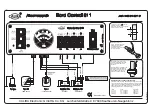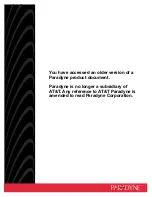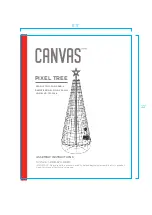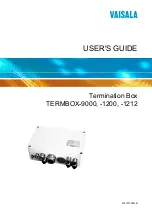
®
M o d e l N o . P S - 2 1 6 8
L i g h t
3
presence of a temperature probe, and will only collect temperature data if a probe is
connected.
To measure temperature, connect the probe and start data collection. Immerse the tip
of the probe in a fluid or place it in contact with an object. The included probe is suit-
able for temperatures between
−
35 °C and
+
135 °C. It can be used in both dry condi-
tions and in liquids, such as water and other mild chemicals and solutions.
Tip: Keep the connector of the probe and the body of the multi-sensor away from liquids. For bet-
ter chemical resistance, use a Teflon
®
cover (CI-6549).
The temperature measurement can be calibrated; however, for most applications cali-
bration is not necessary. For instructions on calibrating in DataStudio, see Appendix
A. For instructions on calibrating on the Xplorer GLX, refer to the Xplorer GLX
Users’ Guide.
Light
The light component of the multi-sensor measures light intensity, or the power per
unit area of light incident on the light-sensitive element. The element is located
behind the black cylinder protruding from the multi-sensor. Though it measures light
intensity, the sensor’s output is calibrated to indicate illuminance in units of lux.
Point the sensor in the direction of a light source and start data collection. The light
sensor has three ranges, which you select using the three buttons on the multi-sensor.
To select a range, push one of the buttons: for 0 lux to 100 lux, for 0 lux to 10000
lux, or
for 0 to 150000 lux. Lights on the buttons indicate which range is selected.
To determine which range is appropriate, look at the data (on a Graph display, for
instance) while it is being collected; if the measurement appears to be “railed” at the
top of the selected range (100 lux or 10000 lux), select the next higher range. You can
push a button to change the range without stopping data collection.
Tip: If you anticipate that the measured value will increase during your experiment, select a higher
range.
Tip: Fluorescent lights flicker at a high rate (100 Hz or 120 Hz), which causes aliasing, or the illu-
sion of a lower-frequency periodic signal, in data collected at relatively low sampling rates. For
this reason, it is recommended that the General Science MultiMeasure Sensor be used to mea-
sure light from incandescent bulbs and natural light sources. To measure high-frequency light
sources, use the PS-2106 Light Sensor, with a maximum sampling rate of 1000 Hz.
Sound Level
The sound component sensor measures sound level on the dbA weighting scale. This
weighting scale is designed to match the frequency response of the human ear and is
commonly used to measure environmental sound levels. The table (right) shows some
typical sound levels.
Voltage
Use the voltage component of the multi-sensor to measure electric potential differ-
ence between the terminals of a battery or power supply, or two points on a circuit.
The voltage probe has two connectors: red and black. The sensor measures the volt-
age of the red connector in reference to the black connector. Its range is
±
24 V.
Light indicates
selected range
100 lux
10000 lux
150000 lux
Range
Source
Sound
Level
(dBA)
Rustling
leaves
20
Library
40
Normal
conversation
60
Noisy office
80
Subway train
100
Rock concert
120
























